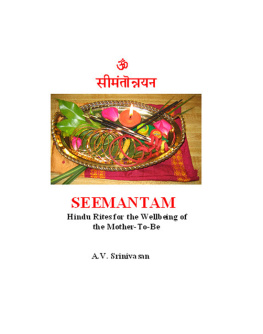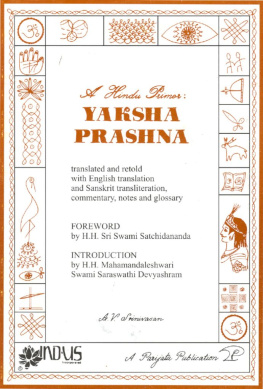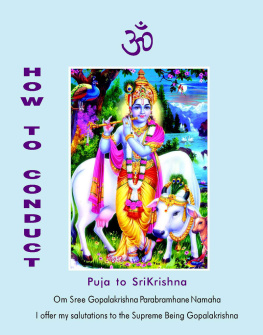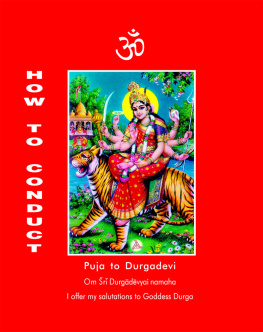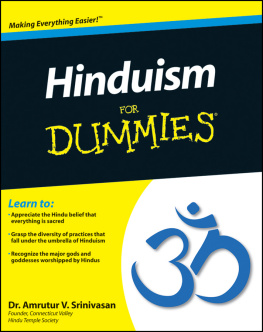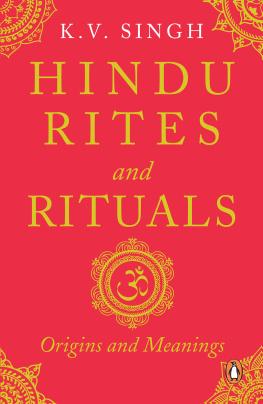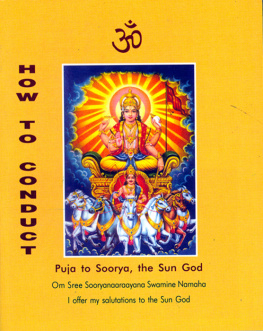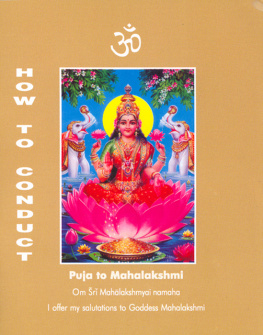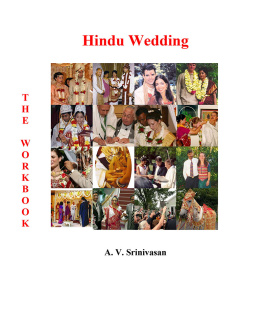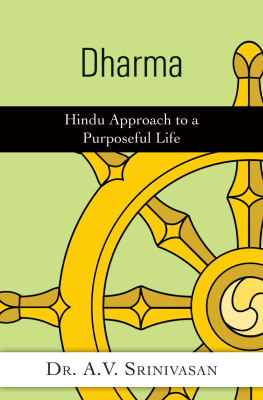A.V. Srinivasan - Seemantam: Hindu Prenatal Rites
Here you can read online A.V. Srinivasan - Seemantam: Hindu Prenatal Rites full text of the book (entire story) in english for free. Download pdf and epub, get meaning, cover and reviews about this ebook. year: 2011, publisher: A.V. Srinivasan, genre: Home and family. Description of the work, (preface) as well as reviews are available. Best literature library LitArk.com created for fans of good reading and offers a wide selection of genres:
Romance novel
Science fiction
Adventure
Detective
Science
History
Home and family
Prose
Art
Politics
Computer
Non-fiction
Religion
Business
Children
Humor
Choose a favorite category and find really read worthwhile books. Enjoy immersion in the world of imagination, feel the emotions of the characters or learn something new for yourself, make an fascinating discovery.
- Book:Seemantam: Hindu Prenatal Rites
- Author:
- Publisher:A.V. Srinivasan
- Genre:
- Year:2011
- Rating:4 / 5
- Favourites:Add to favourites
- Your mark:
- 80
- 1
- 2
- 3
- 4
- 5
Seemantam: Hindu Prenatal Rites: summary, description and annotation
We offer to read an annotation, description, summary or preface (depends on what the author of the book "Seemantam: Hindu Prenatal Rites" wrote himself). If you haven't found the necessary information about the book — write in the comments, we will try to find it.
Seemantam: Hindu Prenatal Rites — read online for free the complete book (whole text) full work
Below is the text of the book, divided by pages. System saving the place of the last page read, allows you to conveniently read the book "Seemantam: Hindu Prenatal Rites" online for free, without having to search again every time where you left off. Put a bookmark, and you can go to the page where you finished reading at any time.
Font size:
Interval:
Bookmark:
Seemantam: Hindu Prenatal Rites
Rites for the Wellbeing of the Mother-To-Be
A Parijata Publication
2012

Puja Booklet Series
by A.V. Srinivasan
How to Conduct Puja
in the privacy of your own home in America
and in the company of your family and friends
How to Conduct Puja to Soorya
How to Conduct Puja to Shiva
How to Conduct Puja to SriRamachandra
How to Conduct Puja to SriKrishna
How to Conduct Puja to MahaaGanapati
How to Conduct Puja to Goddess Saraswati
How to Conduct Puja to Durgadevi
How to Conduct Puja to Mahalakshmi
How to Conduct Puja to the Navagrahas
See Other Publications at the end of the booklet
Copyright A. V. Srinivasan; Periplus Line LLC, 2012
e-Edition
ISBN: 978-1-62209-299-4
All rights reserved. No part of this book may be reproduced or utilized in any form or by any means, electronic or mechanical, including photocopying, recording, or by any information storage or retrieval system, without permission in writing from the Publisher:
Periplus Line LLC
P.O. Box 56
East Glastonbury, CT 06025-0056
U.S.A.
Parijata Publications is an imprint of Periplus Line LLC
www.periplusbooks.com
Illustrations: Bapu
Art Studio: K. Srinivasan

vakratunda mahaakaaya sooryakoti samaprabhaa
nirvighnam kuru medeva adya kaaryeshu adyadaa
O Lord of the curved tusk, immense being, blazing with the brilliance of a million suns, please remove all obstacles in this undertaking today
Authors Transliteration Note:
The print version of this book has the Sanskrit mantras in the Devanagari script along with diacritical marks in transliteration. However in this ebook, we have omitted the Sanskrit text and diacritical marks due to the lack of a uniform standard among all ebook outlets. Instead a simpler approach is included and customary Anglicized spelling may occur in the English text.
List of Abbreviations:
| AV | Atharva Veda |
| AsvaGS | Ashvalayana Grihya Sutra |
| GS | Grihya Sutra |
| KYV | Krishna Yajur Veda |
| MB | Mantra Brahmana |
| ParasGS | Paraskara Grihya Sutra |
| RV | Rg Veda |
| SankhGS | Sankhayana Grihya Sutra |
| SV | Sama Veda |
| YPP | Yajusha Purva Prayoga |
| YV | Yajur Veda |
The Vedic ceremony, known as Seemantam or Seemantonnayana, a prenatal ceremony, is one of the samskaras (Hindi: sanskar) or rites of passage prescribed for Hindus. It involves purification and protective rites aimed at assuring a safe birth of a baby while cheering and felicitating the mother-to-be. In Gujarat and some parts of Northern India, this ceremony is also known as Shrimant, Khodo Bharavo or Godh Bharai, and principally involves filling the lap of the mother-to-be with symbols of prosperity as will be discussed later. It is a ceremony scheduled to be performed during the later part of the pregnancy and is usually done only once, during the first pregnancy. Generally it has been treated as a function organized and performed by the female relatives and friends of the family. However a study of the relevant literature indicates a Vedic basis for the samskar which is the subject of this book.
The dictionary meaning of the Sanskrit word Simantonnayana is parting of the hair. In the celebrated Sanskrit dictionary of Sir Monier Monier-Williams, the words simanta, unnayana and simantonnayana have essentially identical translations. Suffice it to say that in practice one understands the word Simanta or the longer Simantonnayana to refer simply to the ceremonial parting of the hair of a pregnant woman in a ritual act performed by the husband.
Yet another interpretation is attributed to Manu where the word Simanta is defined as Pancha Sandhi implying the region or boundary where the five senses meet. Clearly this is the region on the top of the head and Unnayana is translated as either protection or enhancement. The primary intent of the ceremony may therefore be considered symbolic of that of protection.
In the ceremony a tiny bundle is assembled using a porcupine quill, a small bunch of unripe udumbara (fig) fruits and three darbha grass leaves, all tied together by means of a turmeric-tinted triple twisted thread. This assembly is then used to part the wifes hair, stroking the parting gently from the front toward the back of the head. The stroking is done three times as three corresponding mantras are chanted. This gesture is a display of affection which, in fact, constitutes the core ceremony, and offers an occasion to acknowledge and own the paternal relationship publicly in front of relatives and friends.
According to Rajbali Pande, the only pre-sutra reference to this ceremony is found in the Samaveda Mantra Brahmana:
om yenaadite: seemaanam nayati prajaapatirmahate saubhaagaaya
tenaahamasyai seemaanam nayaami prajaamasyai jaradashthi krnomi
As Prajapati establishes the boundary of Aditi for great prosperity,
so do I part the hair of this woman and make her progeny live to old age.
As is evident from the source of this defining shloka, i.e. Mantra Brahmana in Sama Veda, it is worth noting that many of the governing mantras for this unique ceremony are scattered around many Hindu scriptures: the four Vedas, several Grihya Sutras, Brahmanas, to name a few. Some attempts to provide a systematic compilation have been made (notably by Swami Dayanand Saraswati, founder of Arya Samaj, Rajbali Pande and some treatises in the vernacular languages) but other related ceremonies such as Garbhadanam and Pumsavanam discussed in such references can be a distraction and somewhat out of place in the modern world. Some references that present this topic also vary in their treatment and do not always cite sources.
Thus the effort here to provide an organized, systematic approach is aimed at serving the needs of those young women and their families who wish to perform a Vedic-based traditional Seemantam ceremony. Where relevant we have borrowed some mantras from related ceremonies to provide a focused approach leading to a single ceremony that may meet the requirements of the scriptures and satisfy the families. This How to Conduct . approach should make it possible for young Hindus to understand the spirit, meaning and implications of the ceremony so that they may fulfill their desire of observing an ancient ritual and family custom in a modern context.
In South India, this ritual is generally one of three ceremonies performed during the first pregnancy. For example, the bangles ceremony and the ceremony grooming and feasting the new mother-to-be take place at home, performed by the ladies in both families and female friends, during the fourth and sixth months. The hair-parting ceremony performed by the husband assisted by a priest is more of a public ceremony normally scheduled around the seventh month. For the convenience of all concerned, in this modern age, these rites are combined here, emphasizing their Vedic character as described in the Grihya Sutras.
The ancients were motivated, perhaps, by fear of enemies, the effect of ill will, demons, adverse astrological signs and portents, and the like. The nature and scope of our fears may now differ; modern demonic fears may encompass: pollution, bacteria, genetic disorders, viruses, loneliness, stress. And therefore prayers for our wellbeing remain relevant.
Next pageFont size:
Interval:
Bookmark:
Similar books «Seemantam: Hindu Prenatal Rites»
Look at similar books to Seemantam: Hindu Prenatal Rites. We have selected literature similar in name and meaning in the hope of providing readers with more options to find new, interesting, not yet read works.
Discussion, reviews of the book Seemantam: Hindu Prenatal Rites and just readers' own opinions. Leave your comments, write what you think about the work, its meaning or the main characters. Specify what exactly you liked and what you didn't like, and why you think so.

